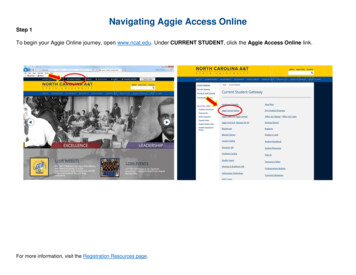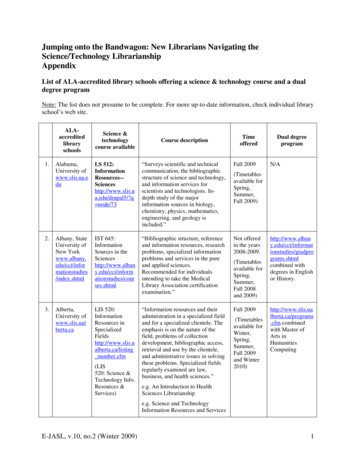
Transcription
Guide to Navigating theNew Overtime Regulations
Table of ContentsSection I – Introduction 2Section II – The FLSA: Let’s Get Back to Basics 3-6-FLSA Coverage-Enterprise Rule-Individual Employee Coverage Rule-Non-Exempt vs. Exempt Employees-Highly Compensated Employee Exemption-OvertimeSection III – The Final Rule 7-8-How Might the Changes Affect Businesses?Section IV – Making a Plan 9-10Section V – Need a Hand? Paychex Can Help 11-12
Section IIntroductionThe Fair Labor Standards Act (FLSA)requires that employers pay eligible nonexempt employees an overtime premiumof at least 1.5 times their regular rateof pay for hours worked over 40 in aworkweek.Now, the U.S. Department of Labor(DOL) has extended overtimeprotections to far more employeesby approving a revision to the federalovertime regulations, and an increaseto the salary threshold for the executive,administrative, and professional whitecollar exemptions from the overtimeprovisions, effective December 1, 2016.On May 18, 2016 the DOL announcedthe Final Rule that will double theweekly salary threshold from 455( 23,660 annually) to 913( 47,476 annually), for the executive,administrative, and professional whitecollar exemptions under the FLSA.The Final Rule expands the number of employees eligible for federal overtime protections. Certain typesof businesses that tend to have a significant number of exempt managers who currently make more than 23,660 annually, but less than 47,476 annually — such as restaurants, daycare facilities, manufacturers,and retailers — could be affected most by the rule.Due to this new rule, businesses may face increasing payroll costs and the potential for expandedrecordkeeping requirements for certain employees. That’s why we’ve assembled this guide to provide youwith an overview of the FLSA, how your company might be impacted by the new rule, and what you cando to prepare.2
Section IIThe FLSA: Let’s Get Back to BasicsThe FLSA is a federal law that includes standards for minimum wage and overtime pay for coveredemployees. Before we dive into the new rule and its changes to the salary thresholds for exemptionfrom those standards and how it may affect your business, it’s important to understand what theFLSA does and does not address:FLSA Established Standards for:FLSA Does Not Address Standards for: minimum wage vacation, sick, or severance overtime premium pay for weekend or holiday work child labor, and pay raises recordkeeping requirements. fringe benefits discharge notices, and final pay.3
FLSA CoverageIndividual Employee Coverage RuleNow let’s review who’s actually coveredThe Individual Employee Coverage Rule applies toby the FLSA provisions.employees whose own actions involve the handlingor production of goods for interstate commerce. DomesticThe FLSA covers more than 130 millionservice workers are also normally covered under the law.workers, both full time and part time,in both the private and public sectors.Employees may be covered under theFLSA by the EnterpriseRule (byworking for a covered employer) or theIndividual Employee CoverageRule.Enterprise RuleThe Enterprise Rule applies to employeesworking for: employers with at least 500,000 inannual sales who have two or moreemployees engaged in interstatecommerce or the production ofgoods for interstate commerce,or handling, selling, or working ongoods or materials that have beenmoved in or produced for interstatecommerce, or employers that are a hospital,nursing home, preschool,elementary or secondary school,college, or a federal, state, or localgovernment agency.4
Non-Exempt vs. Exempt EmployeesEven though an employee may be covered underthe FLSA, they may be exempt from some or allof the provisions of the law and its regulations.A covered employee who is eligible for all theprotections of the FLSA is considered to be anon-exempt employee. Other covered employeesmay be exempt from some or all of theprotections of the FLSA. You may be familiar withthe “white-collar” exemptions. Employees whomeet the requirements for these exemptions areexempt from the minimum wage and overtimeprovisions of the FLSA.Here’s a look at some of the differences between non-exempt employeesand employees who meet the criteria for one of the white-collar exemptions:Non-ExemptEmployees: S ubject to all of the protections of the FLSAWhite-CollarExempt Employees: Position must meet the job duties testfor one of the “white-collar” exemptions M ay be paid on an hourly, salary, piecerate, or commission basis M ust earn at least the federal minimumwage for all hours worked Exempt from the minimum wage andovertime provisions of the FLSA Generally must be paid ona salaried or fee basis M ust be paid the appropriate overtime pay Generally must be paid a minimumfor hours worked over 40 in the workweekof 455/week (This will increase to 913/week on December 1, 2016)5
OvertimeAs we’ve already learned, overtime is one of the keyprovisions of the FLSA. But with changes on the horizon,let’s review what overtime pay entails.Employers are required to pay an overtime premium tonon-exempt employees for all hours worked in excess of40 hours in a workweek. That premium is a rate of at least1.5 times the employee’s regular rate of pay, regardless ofthe employee’s basis of pay — hourly, salary, piece rate,commission, or any combination there of.Highly CompensatedEmployee ExemptionThe regular rate of pay is determined by dividing theThe Highly Compensated Employeetheir wages, non-discretionary bonus, and commission(HCE) exemption is another exemptionpayments where applicable, by the total number ofunder the FLSA. These are employeeshours worked in that week. The hourly rate for overtimewho are also exempt from the minimumwould then be 1.5 times that regular rate.wage and overtime provisions of the Act.To be eligible for the HCE exemption,emplyees must: have total annual compensationof at least 100,000/year be paid at least 455/week ona salary basis perform office or non-manual work,and customarily and regularly performone or more of the exempt dutiesidentified in the standard testsemployee’s total compensation for the week, includingIn determining overtime rates, employers must countall hours worked by the employee in the workweek.Hours worked includes any work carried out by theemployee, even if the work was not requested by theemployer. Hours worked includes all compensabletime. Compensable time may include: travel time time spent in lectures, meetings, and training breaks and meal periods waiting time or on-call time, and sleeping time.for executive, administrative, orThe criteria for the determination of compensable timeprofessional exemptions.can be fact-specific so you may want to consult an HRHowever, as of December 1, 2016, theprofessional, labor and employment attorney, or thetotal annual compensation requirementDOL’s fact sheet on hours worked under the FLSA.needed to meet the HCE exemptionOvertime pay cannot be waived by the employee. If thewould increase from 100,000/year toemployee works the time, the employee must be paid 134,004/year. To be exempt as an HCE,for that time in accordance with the FLSA and applicablean employee must also receive at leaststate law.the new standard salary amount of 913per week on a salary or fee basis andpass a minimal duties test.6
Section IIIThe Final Rule—What Will Change?On May 18, 2016, theDOL announced therelease of their Final Ruleto Update the RegulationsDefining and Delimiting theExemption for Executive,Administrative, andProfessional Employeesunder the FLSA, effectiveDecember 1, 2016. Thechanges include: A n increase to the minimum salary level for exempt workers in the executive, administrative, andprofessional white-collar exemptions- The threshold will be indexed to the 40th percentile of the weekly earnings for full-time salaried workersin the lowest income Census region (currently the South). On December 1, 2016, the threshold willincrease from 455/week ( 23,660/year) to 913/week ( 47,476/year). T he total annual compensation requirement needed to meet the HCE exemption will increase from 100,000/year to 134,000/year, which is equal to the 90th percentile of the weekly earnings forfull-time salaried workers nationally. The HCE salary threshold will be adjusted every three years. S alary thresholds for the executive, administrative, and professional exemptions will be adjusted everythree years to ensure the threshold is maintained at the 40th percentile of weekly earnings for full-timesalaried workers in the lowest income census region.- Based on projections of wage growth, the threshold is expected to rise to more than 51,000 with thefirst update on January 1, 2020. N on-discretionary bonuses and incentive payments (including commissions) may be counted towardup to 10 percent of the new standard salary level for the executive, administrative and professionalexemptions, when applied as detailed in the Final Rule.7
According to the DOL: 4.2 million workers will be affected by the Final Rule based on their current salaries.These workers are currently ineligible for overtime. The DOL estimates that most of them (4.1 million) willbecome eligible for overtime when they work more than 40 hours (i.e., they will be converted to overtimeeligible status), while others (100,000) will receive a raise so that their salary is above the new threshold.How Might the Final Rule Affect Businesses? Increased payroll expenses through additional overtime or higher salaries Employee morale issues (some employees may associate a change in status as a demotion). Increased hiring to avoid overtime hours, or The need to downsize to mitigate payroll expenses.While these changes may present similar challenges for your business, there are important steps you can taketo prepare for what lies ahead.8
Section IVMaking a PlanThe DOL announced the release of theirFinal Rule to Update the RegulationsDefining and Delimiting the Exemptionfor Executive, Administrative, andProfessional Employees on May 18, 2016,with a December 1, 2016, effective date.While this may seem like enough timeto adapt, these changes may result indifficult decisions and administrative tasksthat can quickly consume your schedule.That’s why it’s important to have a plan inplace before these changes take effect.With a solid plan, you can make thenecessary adjustments to help mitigatedisruption to your business operations.Here are a few steps you may consider:Step 1Step 2Step 3Review your payroll andDecide whether youIf you decide to transitionidentify those exemptintend to increase theirpositions to non-exemptemployees whose salarysalary to maintain exemptstatus, determine an hourlyis below the new salarystatus or transition to non-rate and whether overtimethresholds. Be sure toexempt status.will be necessary for theseconfirm their exempt statusemployees. When youusing the duties test as wellmake these changes, beas the salary threshold.consistent to help mitigatediscrimination claims.9
Step 4Step 7Identify employees currentlyVerify you have a written overtime policy indicatingexempt under the HCEwhether overtime hours must be approved inexemption. Do you needadvance and by whom. Consider indicating disciplineto increase their salary tomay result where employees fail to follow the policyretain the exemption? Can— implement the policy consistently and always paythey qualify for one of theemployees for overtime worked!white-collar exemptions? Dothey still meet the job dutiescriteria for an exemption?Step 8Review FLSA (and state) recordkeepingStep 5requirements and update your procedures to helpensure full compliance. As a reminder, here’s a lookReview your proceduresat some of the recordkeeping requirements underand training for supervisorsthe FLSA for non-exempt employees:and managers on yourtimekeeping policies. Besure to address what isconsidered compensable- time and day that each employee’s work weekbegins- hours worked each day per employeetime for non-exempt- total hours worked each week per employeeemployees.- basis on which an employee’s wages are paid— hourly, salary, or piece rateStep 6- regular hourly pay rateConfirm you have a written- total daily or weekly straight-time earningspolicy requiring all non-- total overtime earnings for the workweekexempt employees to tracktheir time worked and aconsistent method forStep 9tracking, e.g., time sheets,Develop your communication plan! Considertime clock, or time andcommunicating with managers/supervisors firstattendance software.and then with impacted employees and the staffat large.10
Section VNeed a Hand? Paychex Can HelpThe new overtime rule will likely affect business operations across the country, but you don’t have to go italone. Paychex offers time and attendance and HR solutions that can help you make informed decisions,manage costs, and develop strategies that make sense for your business.With payroll integration and real-time visibility to data, flexible time and attendance solutions from Paychexcan help you:Track EmployeeHours WorkedVerifyAccurate PayControl CostsCapture and record up-to-Review and edit time cardsIncrease awareness of keythe-minute employee hourswith just a few clicks.labor details so you canworked with flexible timeHelp minimize humanproactively control your mostrecording options, includingerror in manual time-sheetvaluable and expensivetouch-screen HID andpreparation.resource. Receive automaticbiometric clocks, tablet kioskalerts identifying employeessoftware, and Web punch.approaching overtime hours.11
Paychex also offers the supportof an experienced and dedicatedHR professional who can provide: T ools and guidance to help you determine youremployees’ status under the FLSA(exempt vs. non-exempt) Assistance in developing your company policesrelated to full- and part-time hours, overtimeprocedures, and employee classifications. R esources on how you can track employeehours worked to help you comply with thenew overtime rules, and M anagement training and employee-focusedseminars on a variety of employment law topicsFind out how Paychex can help you prepare for the new overtime rules.Give us a call at 855-979-6059 or visit payx.me/othelp today.The information in these materials should not be considered legal, accounting, or investment advice, and it should notsubstitute for legal, accounting, investment, and other professional advice where the facts and circumstances warrant.It is provided for informational purposes only.162891F 6/27/16If you require legal, accounting, or investment advice, or need other professional assistance, you should always consultyour attorney, accountant, or other professional advisor to discuss your particular facts, circumstances, business, personalfinance, and investment needs.12
time for non-exempt employees. Step 5 Confirm you have a written policy requiring all non-exempt employees to track their time worked and a consistent method for tracking, e.g., time sheets, time clock, or time and attendance software. Step 6 Verify you have a written overtime policy indicating whether overtime hours must be approved in











